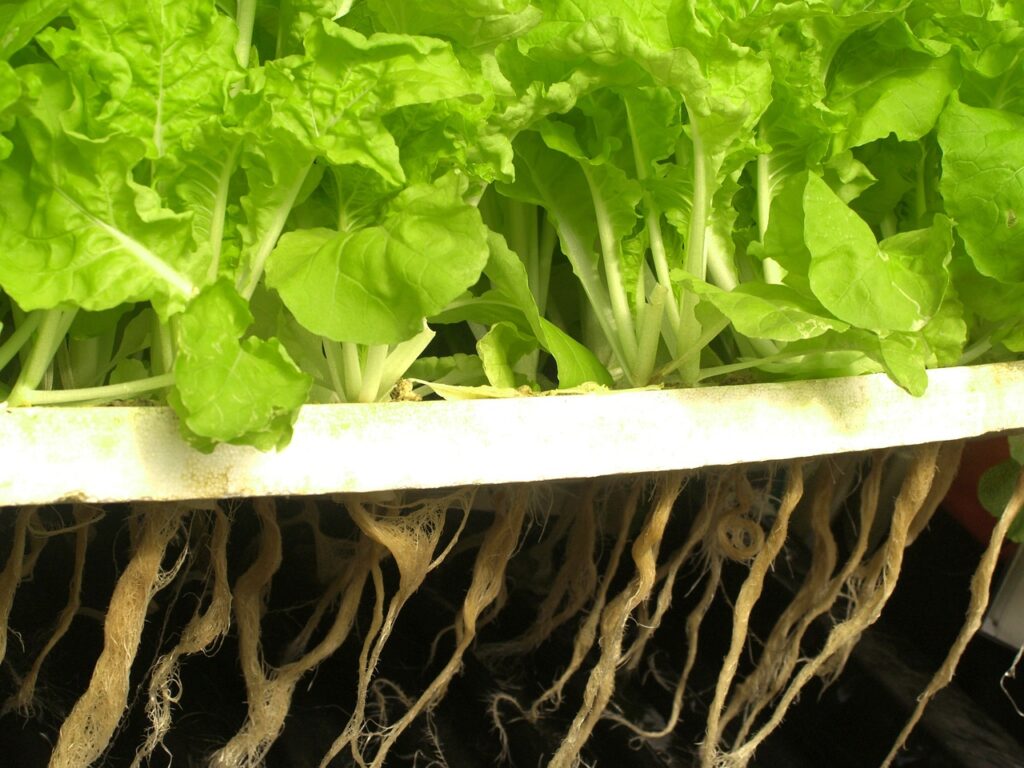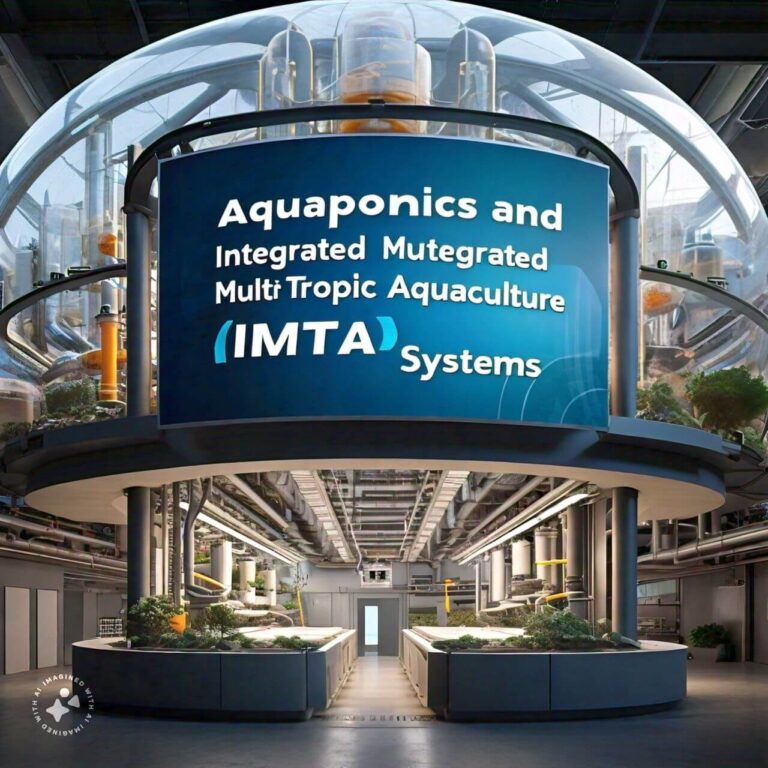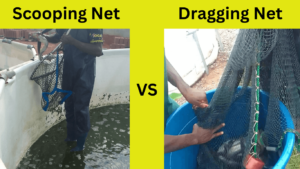Integrated Multi-Trophic Aquaculture (IMTA) systems represent cutting-edge innovations in sustainable agriculture and aquaculture.
These systems are not only pivotal in addressing global food security but also play a crucial role in promoting environmental sustainability.
In this blog will delve into the intricacies of these systems, their benefits, challenges, and future prospects.
Understanding Aquaponics
Before you understand the concept of the Integrated Multi-Trophic Aquaculture (IMTA) System, you need to understand aquaponics first. This is because both are interrelating.
What is Aquaponics?
Aquaponics is a sustainable farming method that combines aquaculture (raising fish) and hydroponics (growing plants without soil).
This system creates a symbiotic environment where fish waste provides essential nutrients for plants, and plants, in turn, help to filter and purify the water, which is recirculated back to the fish tanks. This closed-loop system mimics natural ecosystems and enhances resource efficiency.
How Does Aquaponics Work?
The aquaponics system consists of three main components: fish, plants, and bacteria.
Fish excrete waste, primarily in the form of ammonia, which is toxic in high concentrations. Beneficial bacteria convert this ammonia into nitrites and then into nitrates, a form of nitrogen that plants can absorb and use for growth.
As plants take up these nutrients, they clean the water, which is then returned to the fish tanks, creating a sustainable and efficient cycle.
Types of Aquaponics Systems
Aquaponics systems can vary in design and complexity. The three main types include:
Media-Based Aquaponics
In media-based aquaponics, plants are grown in a medium such as gravel or clay pellets.
The medium provides support for the plants and a surface area for bacteria to thrive. Water from the fish tanks is pumped through the media, allowing plants to absorb nutrients.
Nutrient Film Technique (NFT)
NFT involves growing plants in a shallow stream of nutrient-rich water. The water flows over the roots of the plants, providing them with essential nutrients. This method is efficient and suitable for growing leafy greens and herbs.
Deep Water Culture (DWC)
DWC, also known as raft aquaponics, involves suspending plants on rafts that float on a nutrient-rich water reservoir. This method is ideal for growing larger plants and can support higher plant densities.

Benefits of Aquaponics
Sustainability
Aquaponics systems are highly sustainable. They use significantly less water compared to traditional soil-based agriculture since water is recirculated within the system. This makes aquaponics ideal for regions with limited water resources.
Organic Production
Aquaponics can produce organic crops and fish since it eliminates the need for chemical fertilizers and pesticides.
The closed-loop system reduces the risk of contaminants and promotes healthier produce.
Space Efficiency
Aquaponics systems can be set up in urban environments, making use of available space such as rooftops and basements.
This allows for local food production, reducing the carbon footprint associated with transportation.
Year-Round Production
With controlled environmental conditions, aquaponics systems can operate year-round, providing a continuous supply of fresh produce and fish regardless of seasonal changes.
Challenges of Aquaponics
Initial Setup Costs
The initial setup costs for aquaponics systems can be high, including expenses for tanks, pumps, grow beds, and other equipment.
However, these costs can be offset by the long-term benefits and savings on water and fertilizers.
Technical Knowledge
Operating an aquaponics system requires a certain level of technical knowledge. Understanding the balance between fish and plant needs, water quality management, and system maintenance is crucial for success.
Disease Management
Aquaponics systems can be susceptible to diseases that affect both fish and plants. Monitoring and maintaining water quality, along with implementing biosecurity measures, are essential to prevent and manage diseases.
Integrated Multi-Trophic Aquaculture (IMTA)
What is IMTA?
Finally we are here. I know that is what you have been waiting for since. Let’s delve in.
Integrated Multi-Trophic Aquaculture (IMTA) is an innovative approach to aquaculture that involves the co-cultivation of species from different trophic levels within the same system.
In an IMTA system, species such as fish, shellfish, and seaweeds are grown together in a way that mimics natural ecosystems. This integrated approach enhances resource efficiency and reduces environmental impacts.
How Does IMTA Work?
IMTA leverages the natural relationships between species at different trophic levels. For example, fish excrete waste that can be utilized by filter-feeding shellfish and nutrient-absorbing seaweeds. This not only reduces waste but also improves water quality and overall system health.
Components of an IMTA System
An IMTA system typically includes three main components:
Fed Species
These are species that require external feed, such as fish or shrimp. Their waste products serve as nutrients for other organisms in the system.
Extractive Species
Extractive species include filter feeders like mussels and oysters, which consume organic particles and help to clean the water.
Photosynthetic Species
Photosynthetic species, such as seaweeds and algae, absorb dissolved nutrients and play a crucial role in maintaining water quality and providing additional products for the market.
Benefits of IMTA
Environmental Sustainability
IMTA systems mimic natural ecosystems, reducing the environmental impact of aquaculture. By utilizing waste products as resources, IMTA minimizes nutrient pollution and enhances overall system efficiency.
Economic Viability
IMTA systems can enhance economic viability by diversifying products and increasing overall yields. The co-cultivation of multiple species creates additional revenue streams and reduces risks associated with single-species aquaculture.
Improved Water Quality
The integration of filter-feeding and photosynthetic species improves water quality by reducing organic and inorganic waste. This creates a healthier environment for all species within the system. If you jeopardize the quality of the water for your fish and you can loose all your fish. Water quality is very paramount in this system.
Resilience and Disease Management
IMTA systems are more resilient to diseases and environmental changes. The presence of diverse species helps to maintain ecological balance and reduce the spread of pathogens.
Challenges of IMTA
Complex Management
Managing an IMTA system requires a deep understanding of the interactions between different species. Balancing the needs of fed, extractive, and photosynthetic species can be complex and requires careful planning.
Market Demand
The success of IMTA systems depends on market demand for all cultivated species. Developing markets for less commonly consumed species, such as seaweeds, can be challenging but presents an opportunity for innovation. So you need to adopt modern methods of marketing such as social media marketing strategies.
Regulatory Hurdles
IMTA systems may face regulatory hurdles related to permits and environmental assessments. Navigating these regulations can be time-consuming and requires collaboration with regulatory bodies.
Comparing Aquaponics and IMTA
Similarities
Both aquaponics and IMTA systems emphasize sustainability and resource efficiency. They mimic natural ecosystems and promote the recycling of nutrients. Both systems can enhance food security and reduce environmental impacts associated with conventional agriculture and aquaculture.
Differences
The primary difference lies in the type of species involved and the environments they mimic. Aquaponics focuses on freshwater systems with fish and terrestrial plants, while IMTA involves marine or brackish environments with a broader range of aquatic species.
Aquaponics systems are typically smaller and can be implemented in urban settings, making them accessible for hobbyists and small-scale farmers. In contrast, IMTA systems are usually larger and suited for commercial-scale operations, often requiring access to coastal or marine areas.
Integration Potential
There is potential for integrating aquaponics and IMTA principles in certain contexts. For example, freshwater IMTA systems can incorporate aquaponics components to enhance resource use and diversify production. This hybrid approach can provide additional benefits and increase overall system resilience.
Future Prospects of Aquaponics and IMTA
Technological Advancements
Advancements in technology, such as automation and artificial intelligence, are set to revolutionize aquaponics and IMTA systems.
These technologies can optimize system performance, reduce labor costs, and improve monitoring and management practices.
Research and Development
Ongoing research and development efforts are focused on improving the efficiency and scalability of these systems. Innovations in nutrient cycling, disease management, and species selection are paving the way for more robust and productive systems.
Policy and Support
Increased policy support and incentives for sustainable farming practices can accelerate the adoption of aquaponics and IMTA systems. Governments and organizations are recognizing the potential of these systems to contribute to food security and environmental sustainability.
Community Engagement and Education
Community engagement and education are crucial for the widespread adoption of aquaponics and IMTA systems.
Training programs, workshops, and awareness campaigns can empower individuals and communities to implement these sustainable practices.
Global Impact
Aquaponics and IMTA systems have the potential to make a significant global impact. They can address food security challenges in both developed and developing countries, reduce the environmental footprint of agriculture and aquaculture, and promote healthier and more sustainable food systems.
Conclusion
Aquaponics and Integrated Multi-Trophic Aquaculture (IMTA) systems represent transformative approaches to sustainable agriculture and aquaculture.
By mimicking natural ecosystems, these systems enhance resource efficiency, reduce environmental impacts, and provide economic and social benefits.
While challenges remain, ongoing innovations and increased support are paving the way for a more sustainable and resilient future.
As we continue to explore and develop these systems, aquaponics and IMTA hold great promise for addressing some of the most pressing challenges of our time, from food security to environmental sustainability.
To better understand how the Aquaponics and Integrated Multi-Trophic Aquaculture (IMTA) systems better, enroll in a course now. Check out Now.




Have you ever considered publishing an ebook or guestauthoring on other sites? I have a blog based upon on the same subjects you discussand would really like to have you share some stories/information I knowmy visitors would appreciate your work If you’re even remotely interested,feel free to shoot me an e mail